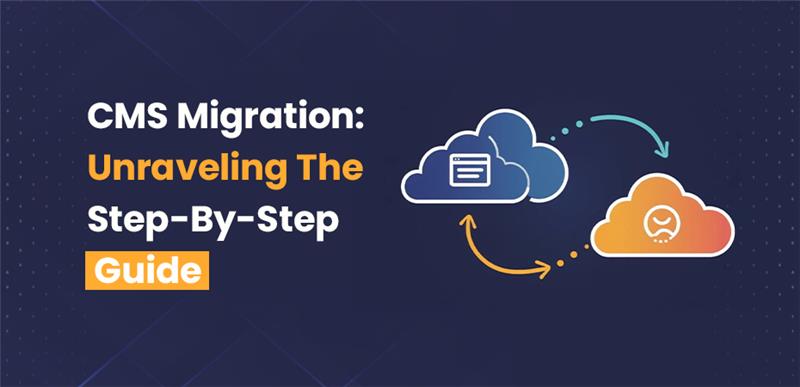CMS Migration: Unraveling The Step-By-Step Guide



In a world increasingly driven by digital technologies, businesses of all sizes are looking to optimize their online presence and improve processes through effective tools like Content Management Systems (CMS). The nuanced process of CMS migration requires careful planning and systematic execution. This data-driven and well-researched guide will help you understand CMS migration better and offer a comprehensive step-by-step guide to ensure successful implementation.
Understanding CMS Migration: Detailed Overview
Content Management System (CMS) migration is a key aspect of website management that involves transferring digital content from one CMS platform to another. This task becomes necessary when an organization’s current CMS no longer serves their evolving needs, pushing them towards an upgrade or complete platform shift.
There are countless Content Management System examples available today, each designed with unique functionalities to cater to varying needs of businesses worldwide. A few popular examples include WordPress, Joomla, Drupal and Magento.
To select the best Content Management System that aligns with their requirements, enterprises should consider factors like ease of use, scalability, and security. However, the migration process itself can be daunting to ensure error-free content transfer. Thus, following a website migration checklist during the CMS migration process can be highly beneficial.
- Backup your current website: It’s important to have a safety net in case something goes wrong during the migration process.
- Evaluate your current content: This step helps identify any outdated or irrelevant content which shouldn’t be transferred to the new platform.
- Test the new CMS thoroughly: Before making the move, ensure that the new CMS is capable of handling your needs and is user-friendly.
- Plan for SEO: To maintain your website’s search engine performance, it’s essential to ensure your URLs, meta-titles and descriptions are preserved in the migration.
Reasons for CMS Migration
There can be numerous reasons that can fuel the decision to migrate to a new Content Management System (CMS). The motives behind such a decision differ extensively depending on the unique requirements of an organization. Let’s discuss some of the common reasons:
1. Improved Performance: One of the leading reasons is the quest for better performance. Accommodating increased website traffic and ensuring faster loading times are crucial aspects of this imperative.
2. Enhanced User Interface (UI): An intuitive and friendly UI can greatly improve the digital experience for users. Migrating to a CMS that offers a more seamless and user-friendly interface is a common motivation.
3. Greater Scalability: As an organization grows, its digital platform too must scale up to meet increased demands. CMS migration often takes place when the current system limits growth and does not support required scalability.
4. Increased Security: With cyber-security threats on the rise, a secure CMS is imperative. Businesses often migrate to CMS platforms which provide advanced security features to safeguard their content.
5. Consolidation: Organizations sometimes find themselves grappling with multiple platforms. Consolidating these platforms into a single CMS not only streamlines operations but also reduces maintenance.
6. Technological Shifts: Rapid advancements in technology make CMS migration inevitable in certain scenarios. Businesses might need to migrate to a Headless Content Management System, for example, because of the increasing demand for omnichannel delivery of content.
7. Content Migration: Business often opt for CMS migration while also considering content migration. This enables the seamless transfer of digital assets from an old system to a new one, ensuring business continuity.
Challenges in CMS Migration
Website Content Management System (CMS) migration can pose a significant challenge due to the complexity involved. It is a procedure that needs to be handled with the right level of expertise to mitigate risks like data loss, broken links disruption, and possible SEO ranking drops. Heartily embraced by many for their websites upgrading, CMS migration is like shifting from an old home to a new one. However, if the process is not planned properly, it may result in a complete mess.
- Data loss: During the CMS migration process, data loss is one of the most common issues experienced. This is usually due to incompatible databases formats between the old and new systems or mishandling of the process. It results in losing valuable data which can impact the functionality and usability of the website.
- Broken links: Broken links error, another fallout of poor migration, restricts users from accessing specific sections of your site. It can be resulting from website pages that were moved but not correctly redirected or because certain pages got deleted during the process.
- SEO Ranking drops: SEO ranking is a key concern during CMS migration. When you change your site structure, URL structure or content during migration, there are high chances the SEO rankings could drop if no adequate SEO migration plan is in place.
These challenges remind how significant meticulous planning is for a successful CMS migration.
A CMS migration tool aids in the transferring of database catalogues, configurations and other relevant data. When considering custom CMS SEO migration, a well-rounded approach is crucial. Ultimately, to survive this task unscathed, a thoroughly designed website content migration plan would be the perfect bulwark against common CMS migration nightmares.
Crucial Planning Stages for CMS Migration
When setting out on a CMS migration journey, a carefully laid plan can make the process seamless and efficient. Here are the critical stages of planning for a smooth DMS migration.
Step 1: Define Your Migration Goals
Usually, the primary motivation behind a CMS migration is to upgrade content management capabilities. However, each transition process comes with other operational goals, such as enhancing SEO management, optimizing user experience, and advancing security features. A website migration SEO checklist can help prioritize these objectives and plan accordingly.
- SEO management: Upgrading SEO features can help enhance your website’s visibility on search engine result pages.
- Improved user experience: A user-friendly interface and easy navigation improve the overall user experience.
- Advanced security: Enhanced security features ensure the safety of user data and protect your website from cyber threats.
Step 2: Inventory and Audit Your Existing Content
An audit and inventory of your existing content set the path for successful CMS migration. Auditing helps you understand what works for your content and what doesn’t, aiding in informed decision-making. A thorough CMS migration checklist includes:
- An inventory of the existing content, which helps decide what should be kept, discarded, or improved.
- An audit of the content’s performance. This step helps identify the strengths and weaknesses of the current content.
Step 3: Choose the Right CMS
Selecting a CMS that caters to your needs is vital for successful migration. Consider various factors like user-friendliness, flexibility, scalability, security, cost, and community support while choosing a CMS. For some, migration to a headless CMS might be a better option owing to its streamlined and effortless content management.
Execution Plan for CMS Migration
Step 4: Pre-Migration Steps
Setting the ground for migration consists of some crucial pre-migration steps. These are essential to minimize disruptions during the migration process. Key pre-migration activities include:
- Creating a backup of the current site to ensure data safety.
- Developing a new environment for the migration process.
- Making sure the new CMS has all the necessary configurations before the commencement of the migration.
Step 5: Performing the Migration
The core phase involves transferring the content from the old CMS to the new one. This step may involve moving various elements like articles, blog posts, media files, user data, etc., to the new CMS. Leveraging CMS migration tools could educate on the transfer of such data smoothly.
Moving to a more advanced and feature-rich CMS like headless CMS could deliver improved performance and better content management capabilities. However, this ‘CMS to CMS migration’ process should be carefully planned and executed to avoid data loss or compatibility issues.
Step 6: Post-Migration Steps
Once the content gets transferred, it’s time to fine-tune your new CMS. This stage includes setting up redirects to maintain the link equity of your site. It also involves re-implementation of SEO strategies to ensure the website’s visibility isn’t compromised. Don’t forget to perform rigorous testing to ensure the site is functioning correctly before it goes live.
In conclusion, a CMS migration process, when carried out systematically and using the appropriate tools, can result in a highly functional, user-friendly, and SEO-optimized website.
Conclusion
The SEO migration guide demonstrates that managing the complexity of CMS migration requires detailed planning, orderly execution, and diligent post-migration tasks. Adhering to these steps will lead to a smoother transition and optimal site performance. To make your CMS migration stress-free and efficient, reach out to Core Web Vitals Consultant today.
Frequently Asked Questions (FAQs)
CMS migration is the process of moving your digital content from one CMS (Content Management System) platform to another, usually done to achieve better performance and improved features.
CMS migration becomes necessary when the current CMS is unable to meet the evolving needs of a business in terms of scalability, performance, security, and usability.
Challenges in CMS migration can include data loss, broken links, SEO ranking drops, and the potential for the site to be temporarily unavailable. Proper planning can help mitigate these challenges.
Choosing the right CMS requires considering factors like ease of use, scalability, security, cost, and the level of community support available. The chosen CMS should align with the company’s needs and growth projections.
A successful CMS migration involves defining migration goals, conducting a content audit, choosing the right CMS, following pre-migration steps, performing the migration, and diligent post-migration tasks.